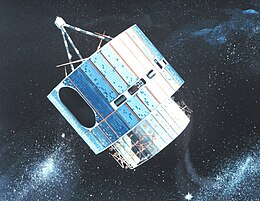GOES-2, known as GOES-B before becoming operational, was a geostationary weather satellite which was operated by the United States National Oceanic and Atmospheric Administration as part of the Geostationary Operational Environmental Satellite system.[4] GOES-2 was built by Ford Aerospace, and was based on the satellite bus developed for the Synchronous Meteorological Satellite programme. At launch it had a mass of 295 kilograms (650 lb).[5] It was positioned in geostationary orbit, from where it was used for weather forecasting in the United States. Following its retirement as a weather satellite, it was used as a communications satellite until its final decommissioning in 2001.

 Artist's impression of an SMS-series GOES satellite in orbit | |
| Mission type | Weather satellite |
|---|---|
| Operator | NOAA / NASA |
| COSPAR ID | 1977-048A |
| SATCAT no. | 10061 |
| Mission duration | 24 years |
| Spacecraft properties | |
| Spacecraft type | SMS |
| Manufacturer | Ford Aerospace |
| Launch mass | 295 kilograms (650 lb) |
| Start of mission | |
| Launch date | 16 June 1977, 10:51:00 UTC |
| Rocket | Delta 2914 |
| Launch site | Cape Canaveral LC-17B |
| Contractor | McDonnell Douglas |
| End of mission | |
| Disposal | Decommissioned |
| Deactivated | 5 May 2001, 21:08 UTC |
| Orbital parameters | |
| Reference system | Geocentric |
| Regime | Geostationary |
| Longitude | 75° West (1977-1978) 100-110° West (1978-1984) 112-114° West (1984-1990) 60° West (1990-1992) 135° West (1992-1995) 177° West (1995-2001)[1][2] |
| Perigee altitude | 35,972 kilometres (22,352 mi) |
| Apogee altitude | 36,094 kilometres (22,428 mi) |
| Inclination | 13.7696º |
| Period | 24 hours |
| Epoch | 17 May 2016, 10:12:31 UTC[3] |
GOES-B was launched using a Delta 2914 carrier rocket flying from Launch Complex 17B at the Cape Canaveral Air Force Station.[2] The launch occurred at 10:51:00 GMT on 16 June 1977.[6] The launch successfully placed GOES-B into a geostationary transfer orbit, from which it raised itself to geostationary orbit by means of an onboard SVM-5 apogee motor. Its insertion into geosynchronous orbit occurred at 03:26 GMT on 17 June.[1]
Following on-orbit testing, GOES-B was redesignated GOES-2, and replaced SMS-1 at a longitude of 60 degrees west. It was operated as a weather satellite at several different positions until 1993, and was then placed into storage. It was reactivated as a communications satellite in 1995, and moved to 177° West. It was used by Peacesat to provide communications services to islands in the Pacific Ocean, a role in which it was replaced by GOES 7 in 1999, and by the US National Science Foundation for communications with the Amundsen–Scott South Pole Station. On 5 May 2001, it was retired to a graveyard orbit. At 21:08 GMT, two hours after the last manoeuvre to remove it from geosynchronous orbit, GOES-2 was commanded to deactivate its communications system, preventing future ground commands being sent to it.
See also
References
Wikiwand in your browser!
Seamless Wikipedia browsing. On steroids.
Every time you click a link to Wikipedia, Wiktionary or Wikiquote in your browser's search results, it will show the modern Wikiwand interface.
Wikiwand extension is a five stars, simple, with minimum permission required to keep your browsing private, safe and transparent.
